|
Yellow tuft, or downy mildew, is caused by the water mold fungus
Sclerophthora macrospora. The disease occurs on most cultivated
turfgrass species, cereals, and many weedy grasses (e.g., crabgrass),
but seldom causes extensive losses, except on turfs maintained at
shorter mowing heights (<1"), such as golf greens. Downy
mildew is usually associated with seedling or immature turfs grown
on poorly drained and/or heavily watered areas. The disease may
so weaken creeping bentgrass that additional stress, such as excessive
traffic, drought, or extreme cold or heat, will kill infected plants.
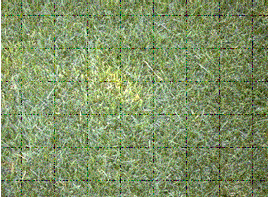 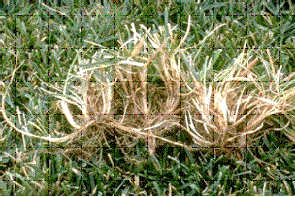
Figure
1.
Yellow tuft: (Left) small yellow patches in a bluegrass
lawn; (right) close-up of infected plants showing excessively
tillered yellow shoots with shallow roots (courtesy Dr.
Noel Jackson).
|
Back to Top
|
Symptoms
Early symptoms of yellow tuft include the appearance of small clumps
of slightly stunted, light green or yellow grass plants which have
slightly thickened or wider leaf blades and exacerbated leaf growth.
When the disease is severe, small yellow patches, 1/4 to 5 inches
in diameter, can be found in the turf (yellow tuft). Patches on
bluegrasses and fescues are usually larger than those found on bentgrasses
and ryegrasses. Each patch contains dense clusters or bunches of
stunted, excessively tillered yellow shoots with shallow roots (Figure
1). Plants in these patches are easily pulled from the turf as their
roots are few and stunted. Infected plants commonly die from a combination
of heat and drought stress, winter desiccation, or attacks by secondary
fungi, such as those that cause leaf smuts and "Helminthosporium"
diseases. Yellow tuft-affected turf appears unsightly, spotted or
mottled, with an uneven surface. During cool, wet periods a white
downy growth (sporangiophores bearing lemon-shaped sporangia; see
Figure 5) may appear on the leaves and leaf sheaths. Symptoms of
yellow tuft or downy mildew are most prominent during late spring
and fall, appearing first in poorly drained areas.
If left unmowed, the heads of infected turfgrass plants assume
abnormal shapes, similar to those associated with phenoxy herbicide
injury (Figure 2).
Back to Top
|
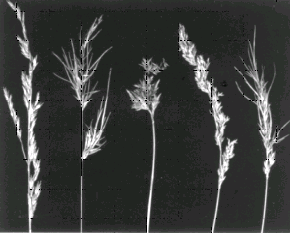
Figure
2.
Heads of K-31 tall fescue distorted by the downy mildew fungus,
Sclerophthora macrospora (courtesy Dr. J.L. Dale).
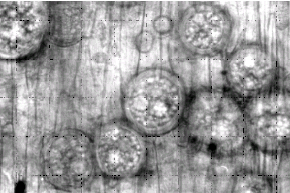
Figure
3.
Thick-walled oospores of Sclerophthora macrospora in infected
bentgrass tissue (courtest Dr. Noel Jackson).
|
Disease Cycle
The Sclerophthora fungus overseasons as mycelium and thick-walled oospores
in living and dead leaves, stems, and crowns (Figure 3). In cool, wet
weather, from late spring into autumn, the fungus produces stalklike fruiting
structures (sporangiophores) that protrude from the stomates on both leaf
surfaces and on leaf sheaths (Figure 4). Pearly white, lemon-shaped sporangia
form on the tips of the sporangiophores. The sporangia (Figure 5) remain
turgid only as long as the leaf surface is wet; on dry leaves they quickly
collapse and appear as a dirty white residue.
When the turf is wet, microscopic sporangia release many spores (zoospores)
that actively swim in search of susceptible turf. The zoospores attach
themselves to leaf surfaces and encyst 1 to 24 hours after being released.
Later, the cysts infect young meristems of healthy plants. Young tissues
are quite susceptible while mature leaves usually resist infection. Numerous
round oospores are produced in infected leaves (Figure 3) and can be seen
with a microscope. The oospores may germinate in the presence of moisture
to produce a sporangium and continue the disease cycle.
Oospores can persist for several months or more in well-drained soils.
A dormant period of at least 8 weeks is required after oospore formation
before germination can occur in the presence of moisture. The sporangia
and oospores can be disseminated in splashing or flowing water, on all
types of turfgrass equipment, shoes, and in infected sod, sprigs, and
plugs. It should be noted that the fungus grows best under conditions
that promote optimal growth of its grass host.
Back to Top
Control
A Cultural Controls
1. When preparing a seedbed be sure that adequate surface and
subsurface drainage is available so excess water will drain quickly.
Avoid overwatering. If possible, remove excess water from grass
surfaces following heavy rains.
2. Fill in low spots where water may stand.
3. Buy only top-quality certified sod, sprigs, plugs, or pathogen-free
seed from a reputable dealer.
4. Mow only when the grass is dry.
5. Manage the turf in a manner that promotes active, but not lush
growth.
6. Fertilize (supply nitrogen, potash, and phosphorus) according
to local recommendations and soil tests. During periods of hot weather,
avoid overstimulation with fertilizer, especially one containing
a high content of water-soluble nitrogen.
7. Remove excess thatch in spring and/or fall. Thatch should be
kept at less than 1/2 inch on lawn-type turf; 1/8 inch or less on
closely mowed turf.
8. Follow suggested insect and weed control programs.
9. Kentucky bluegrass and creeping bentgrass cultivars are not
known to differ in their resistance to yellow tuft or downy mildew.
B. Chemical Control
1. Preventive fungicides effective against species of Pythium
have shown limited success in controlling yellow turf or downy mildew.
The fungicide metalaxyl (sold as Subdue) must be applied before
infection occurs since infected plants cannot be cured. Carefully
follow all directions and precautions as printed on the container
label. Spring applications of metalaxyl are most effective for control
of yellow tuft.
|
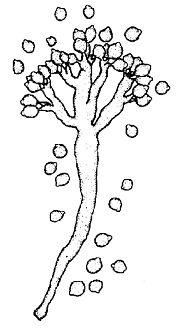
Figure
4. Stalklike,
branched sporangiophore of Sclerophthora macrospora bearing sporangia
(drawing by L. Gray).
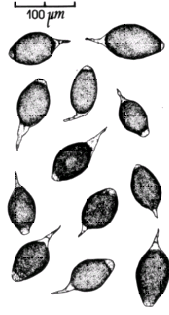
Figure
5. Lemon-shaped sporangia of Sclerophthora macrospora from Kentucky
bluegrass, as seen under a microscope (drawing by L. Gray).
|
Back to Top
|



